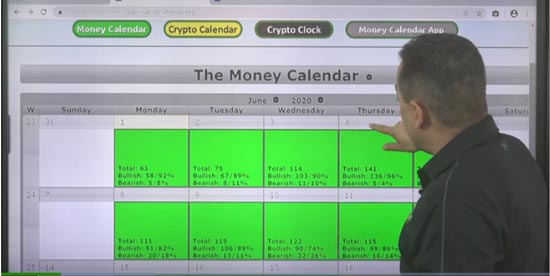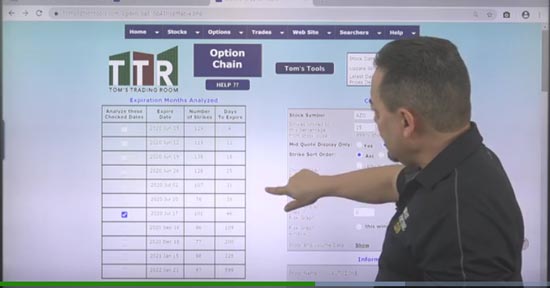It's kind of hard to believe, but we've already entered the month of June, so I wanted to spend time today to walk you through some possible payday situations I'm looking at this month using my proprietary tool, the Money Calendar.
The Money Calendar is the most accurate market predictor I've ever used. As the old adage says, "The best predictor of future behavior is past behavior."
And that's exactly what the Money Calendar does - it analyzes the market's behavior over the last 10 years in order to predict where it will go next.
You see, the Money Calendar takes millions of bits of data and puts them across a minimum of 10 years to find the best patterns up and down in the world's most popular stocks.
And you might think you know where June will go. Businesses are reopening, profits are going back up...
But as I'm about to show you, it's not enough to look at the surface...[mmpazkzone name="in-story" network="9794" site="307044" id="137008" type="4"]
These June Patterns Will Lead Us to Gains
As we jump right into the Money Calendar, you can see that the first two weeks are filled with green. This tells me that the patterns are more bullish than bearish.

For example, looking at Monday, June 1, a total of 63 stocks met the criteria that I use to establish a pattern; 92% of those were bullish, and only 8% were bearish. This is out of about 3,000 to 4,000 stocks. So I'm only looking at the best 1% to 2% of stocks during his time frame.
The whole month looks very bullish, except for a few days from June 18-22.
To drill down to the opportunity, I just click on the day I'm looking at making a trade. If I go ahead and click on June 1, for example, that shows me the stocks that are presenting a bullish pattern, and the trade duration, meaning how long the bullish pattern is going to last.
We've got everything from net profit to accuracy on here, but the most important thing I want to do is to rank this by which one of these have the best patterns right now. In order to do that, I simply go to my Power Meter, and that brings up the best stocks we can look at right now.
And we could get even more detailed at this point, so let's take a look at Autozone.
AZO is a bullish trade between June 1 and July 10. Its bullish pattern lasts for 40 days, including weekends and holidays.
I can look at even more statistics such as net profits, how long the trade's going on, and even the best and worst situations that have happened for this stock in the past 10 years.
Ten years ago, Autozone was not the stock that it is today. It's had some nice patterns, but in the last 10 years, it's really ticked up, and last year, it made over $136 in profit. So I need to factor that in as I'm looking at trades.
What I've done with you so far is that I've showed you the opportunity. The opportunity is between now and July 10 for Autozone. Last year, this trade made $136 of profit in the pattern, but I'm going to factor that into the last three years, and let's just say that maybe it goes up $50 on average over the last three years.
This brings me to step two. I'm going to bring you to an options trade. I'm looking at the Autozone options right now for July 17.

These July 17 options are 46 days to expiration, and they fit really well in this pattern. Now I told you that the pattern ends on July 10, and there are July 10 options, but I've actually checked that the July 17 options actually have more volume, they are more efficient, they have tighter bid-ask spreads, which basically means you can get in and out of them much easier than the July 10 options.
Now, I have to add that Autozone is not a cheap stock. As of this writing, it's $1,137 a share. But let's take a look at its call options. The near-money options are near $1,140 - I don't want those.
I want to go to the target. If I take 50 points from where we are right now, the target is around $1,190.
If I sold these options, I would pay around $35 for those. Now what if I bought around $1,180? This meaning buying the lower strike call and selling the higher strike call. And for this, let's say I pay around $40 for these.
So instead of buying an option that costs almost 40 points, by spreading this off and buying the $1,180 option and sell the $1,190 option, I'm actually going to do that as a spread and I can do that for five points, or $500 per contract.
Key Takeaways: The month of June looks to be for the most part bullish when we look at the last 10 years.
Some of you may be saying, "Wait a minute, we're in unprecedented times, Tom. We've got coronavirus going on, we've got protests that could be impacting the stock market."
While that's all true, look at what happened in May, look at what happened in April... We were in the thick of coronavirus, and yet our bullish patterns turned out quite well.
In addition, there are some bearish opportunities that we can look at, too. But today, I wanted to just give you a quick rundown of how I spot opportunities and how I create these low-risk trades. It's just a matter of placing them with my broker, and after they get executed, managing them. And by that, I mean managing them for profitability and maybe putting something in for stops, as well.
In the meantime, don't forget to check out my latest presentation for this instant cash opportunity...
You see, during a brief 45-second call, I hit a button on my computer, and INSTANT CASH to the tune of $14,288 hit my account.
Get ready to have your mind blown - because you can access a recording of this call right here...
Follow Money Morning on Facebook and Twitter.
About the Author
Tom Gentile, options trading specialist for Money Map Press, is widely known as America's No. 1 Pattern Trader thanks to his nearly 30 years of experience spotting lucrative patterns in options trading. Tom has taught over 300,000 traders his option trading secrets in a variety of settings, including seminars and workshops. He's also a bestselling author of eight books and training courses.



